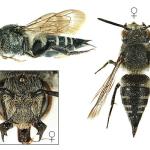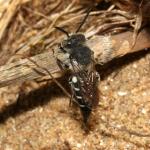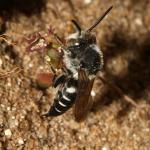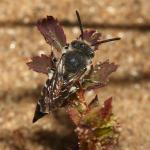Coelioxys mandibularis olgae Cockerell, 1924, Coelioxys mandibularis jeholensis Yasumatsu, 1935
There are currently no published keys to Coelioxys. George Else has a key in preparation. A photographic guide to the genus is available for download from the BWARS website.
Found in disjunct regions of the British Isles, in south-east England and from the south coast of Wales to the Wirral. All locations are coastal dune systems. Not recorded from Ireland or the Channel Islands.
It occurs in much of western Europe, although apparently absent from the Iberian peninsula and the Balkans.
Regarded as Rare (RDB3) in Shirt (1987) and Falk (1991). It has a local Biodiversity Action Plan for the Cheshire Region.
This is a coastal species occurring on sand dunes where its hosts are found.
It is on the wing from July to August.
This species is a cleptoparasite of Megachile maritima (Kirby) and M. leachella Pérez.
Another host, M. circumcincta (Kirby) is also noted. The females of all but one British
species of Coelioxys have a pointed sixth tergite and fifth sternite which is apparently used
to cut open the cell wall or cap of the host species. An egg is laid in this slit with at least
one third protruding through into the cell or laid directly onto the host egg. There is
currently no work to suggest which method C. mandibularis employs. Generally, Coelioxys
larvae kill, and in some species eat, the host egg immediately on hatching. Pupation
occurs within a cocoon spun within the host cell where the larva overwinters as a pre-pupa,
prior to final pupation, presumably in spring of the following year.
There is no information on flowers visited by this species.
No data available.
2012





